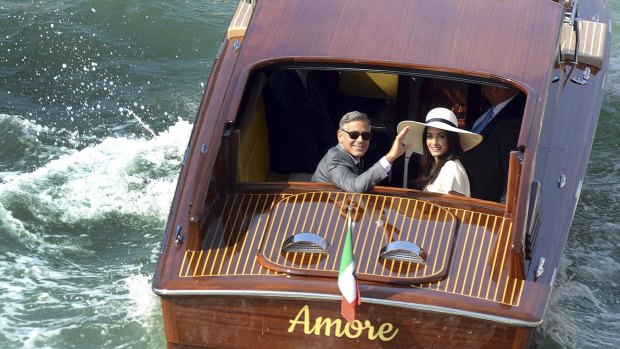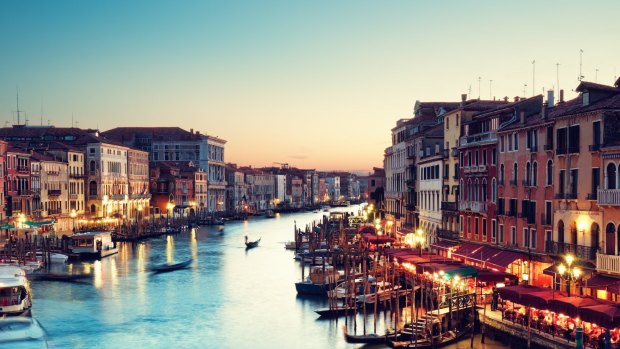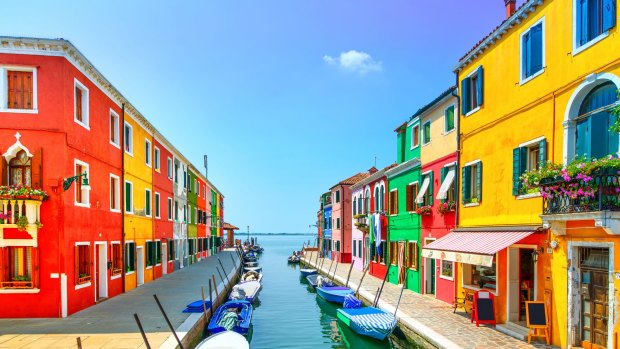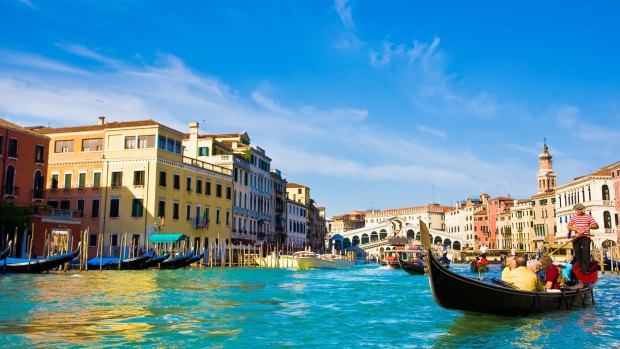This was published 9 years ago
Ten things to do in Venice if you're not George Clooney
By Anne Hanley

The wedding of George Clooney and Amal Alamuddin may have put Venice on the map, but this water-city has long been a tourist magnet.
George Clooney and Amal Alamuddin have put Venice in the headlines this week, but for lesser mortals there is plenty to do in the city for free.
1. Arsenale
The Serene Republic's shipyard, or Arsenale, occupies a large swathe of eastern Venice. Founded in 1104, this huge city-within-the-city of wet and dry docks, warehouses, ropewalks and workshops was a marvel of the pre-industrial world. At its peak, in the early 16th century, it employed 16,000 people on an assembly line that was able to turn out close on a ship a day. Jointly owned by Venice City Council and the Italian Navy, the Arsenale is not regularly open to the public, but parts of the complex are used as exhibition space by the Art and Architecture Biennales, which take place respectively in odd- and even-numbered years (June-November; labiennale.org). Even when the interior is closed, you can admire the four mismatched marble lions outside the glorious Renaissance main gate, all brought back as war loot from various crusades and campaigns.

There is no other city quite like Venice.
Address: Castello, Campo dell'Arsenale, 30122
2. Burano

Brightly coloured houses lined the streets on the Island of Burano near Venice.Credit: Shutterstock
The jauntily hued houses of this populous fishermen's island in the northern lagoon look like the result of a bunch of kids let loose with a giant paintbox. The sheer prettiness of the place tempts plenty of visitors to make the trip across from Venice on the number 12 vaporetto (water bus), as does the island's tradition of merletto (lace). A couple of delightful old lace-making ladies are generally in residence in the mornings at the worthwhile Museo del Merletto (museomerletto.visitmuve.it) in the main square of Piazza Galuppi, where the church of San Martino has an early work by Tiepolo. Little of the lace on sale in the many shops is authentically buranese; the local firm Emilia, at the piazza end of the main street, represents an honourable exception.
Address: Isola di Burano, 30142
3. Giardini Pubblici

Take a gondola ride through the Grand Canal to see Rialto Bridge.Credit: Shutterstock
Outside of a few frustratingly unreachable private gardens, green space is in short supply. If the kids need to let off some steam, or you do, head for the eastern end of Venice, a district laid out late enough in the city's history (the 19th century) for the planners finally to factor a public park into the equation. The part in front of the Giardini vaporetto stop has a kids' play area. Beyond is the entrance to the Giardini della Biennale, open only during the Biennales of Art and Architecture. Apart from what's on show, this is a fascinating space in its own right, a sort of cultural Olympic park dotted with national pavilions, some (like Alvar Aalto's Finnish pavilion) designed by big names. Nearby, in Viale Garibaldi, a former greenhouse is now the bar-restaurant La Serra dei Giardini - a good place for a coffee pit stop.
Address: Castello, Viale dei Giardini Pubblici, 30122
4. Lido
Venice's seaside strip, the Lido, is more of a dormitory suburb and family resort these days than the elegant haunt of moneyed flaneurs that it was in the early part of the 20th century, when Thomas Mann set his wistful, tragic novella Death in Venice here. But this unfussy quality is all part of its charm. Disembark at the main vaporetto stop, walk 10 minutes down the Gran Viale, the Lido's main street, to the sea-facing side of the island, and you can be making sandcastles in no time. If you don't feel like paying for your place in the sun, there's a patch of free beach where the Gran Viale meets the sea, and another in the area of breakwaters beyond the Excelsior hotel. Real beach bums hop on the number 11 bus or hire a bicycle (I always use Anna Gardin: biciclettegardin.com) and head for the dunes at Alberoni, at the far end of the island. The Lido is a sleepy kind of place. It only wakes up for the 10 days in late August and early September when the Venice Film Festival (labiennale.org/it/cinema) comes to town.
Address: Lido di Venezia, 30126
5. Murano
It is fascinating to see glass being blown and fashioned into vases, glasses and souvenir baubles in the various workshops on Venice's historic glass island, but be aware that any Murano excursion offered "free" by your hotel concierge comes with serious pressure to buy at prices that will not be the cheapest. Far better to make your own way there (it's 10 minutes from Fondamente Nove by vaporetto) and shop around. Murano's destiny was written when the Doge transferred all glassmaking activities here in 1291 because of the fire risk in central Venice, but there's more to this enjoyably down-to-earth island than glass. I love the church of Santa Maria and Donato (free entry), which has a fascinating 12th-century Byzantine mosaic floor alive with animal and plant motifs. The Museo del Vetro (museovetro.visitmuve.it) boasts an important collection of historic glassware, including some Roman pieces, though ongoing restoration has meant that for the past few years certain rooms are often closed.
Address: Isola di Murano, 30141
6. Rialto
Venice looks pretty flat to the untrained eye, but there are in fact plenty of peaks and troughs in the lie of the land. Rivoaltus ("high bank") - later shortened to Rialto - was chosen as the site of one of the earliest settlements in the lagoon in the fifth century because it was (relatively) high and dry. When Venice expanded, it remained the city's commercial heart. The market was moved here in 1097, and has remained ever since: this is still the place to come for the best fruit, veg, groceries, fish and meat. The area is reached from the sestiere of San Marco via the Ponte di Rialto, designed between 1588 and 1591 by the aptly named Antonio da Ponte (Tony Bridge) to replace a series of wooden bridges in the same spot, the earliest of which was a 12th-century pontoon affair. The market area has recently become a buzzing nightlife hub, thanks to the opening up of the previously off-limits Grand Canal frontage of Campo Erbaria.
Address: San Polo, 30125
7. Santa Maria della Salute
Dominating the final stretch of the Grand Canal before San Marco, "La Salute", as locals call it, is the uncontested masterpiece of the Venetian Baroque. With its playful scrolls supporting an airy balloon of a dome, the church has an ineffable grace, a lightness that plays against the huge bulk and scale of the thing. It was built between 1631 and 1681 to give thanks for the city's delivery from its final plague epidemic in 1630. Health (salute) and light are built into the very fabric of the church. It was designed in the round, in homage to the "crown of 12 stars" of the Virgin Mary, and also as a kind of moral imperative - an assertion of transparency and clarity in a design whose extent can be taken in, in one glance, as soon as you enter. The best of the art inside is Tintoretto's busy Marriage Feast at Cana in the sacristy, its foreshortened perspective intended to continue the line of the refectory where it once hung.
Address: Dorsoduro, Campo della Salute, 30123
8. San Zaccaria
Few of those who alight or depart at the busy San Marco-San Zaccaria vaporetto stop actually make it to the second of the churches in its name. And yet it would be a shame to miss this very Venetian place of worship, which is dedicated to the father of John the Baptist (his body supposedly lies under the second altar on the right). The church was begun in the prevailing Gothic style in the 1440s. By the time Mauro Codussi completed it 50 years later, the first stirrings of the Renaissance had reached Venice, so it's ended up as a bit of a halfway house. The interior has two unmissable works of art: Giovanni Bellini's masterful Madonna and Four Saints, and the Tuscan artist Andrea Castagno's intensely human saints and putti on the ceiling vaults of the San Tarasio chapel, perhaps the greatest Florentine early Renaissance fresco not actually in Florence. The square outside is a good place for a picnic.
Address: Castello 4693, Campo San Zaccaria, 30122
9. St Mark's Basilica
Resplendent at the eastern end of Piazza San Marco, the sumptuously decorated St Mark's Basilica resembles nothing else in Christendom: at times, it looks more like a mosque or a sultan's palace. From its four great bulbous domes outside to its one and a half square miles of glimmering golden mosaics covering the splendid interior, there's nothing understated about Venice's mother church, begun in the 11th century but not finished until the 16th. Go for 7am, 8am or sung 9am mass if you want to see it without the crowds. Queues to enter lengthen scarily once the basilica opens for tourist visits at 9.45am, but you can avoid the wait by booking a timed entry slot (up to 10 minutes before, if you're lucky) through the basilica's website. Don't forget to visit the upstairs loggia (the Museo di San Marco; admission euros 4/$A5.75) where the originals of the four Graeco-Roman bronze horses that face the square prance elegantly in a museum that also affords spectacular views over the piazza. Other pay-to-enter sections inside the church include the Chancel and Pala d'Oro (euros 2/$A2.90) - a dazzlingly OTT Byzantine altarpiece ablaze with gold and gems - and the Treasury (euros 3/$A4.30), with its hoard of (mostly plundered) gold, silver and onyx church ornaments.
10. Torcello
This is where it all started, back in the fifth century, when citizens of the Roman town of Altino on the mainland fled into the lagoon to escape Barbarian invasions (Attila the Hun, it seems, was not much of a sailor). By the 14th century, Torcello was the most populous island on the lagoon, but the rival settlement of Venice, centred on the Rialto, soon gained the upper hand, and today this sleepy, rural island in the northern lagoon is a poignant witness to past glories. Two handsome churches are among the few remnants of the years when it could have been a contender: the ancient Basilica of Santa Maria Assunta (for which there is an admission fee of euros 5/$A7.20), begun in the ninth century, is simple on the outside but richly decorated inside with mosaics dating from the ninth to the 12th centuries; austere Santa Fosca (free admission) is a perfect, unadorned Greek-cross church from the 11th century. To get there, take the number 12 vaporetto from Fondamente Nove on the northern shore of Venice proper, and change to the number 9 at Burano for the five-minute hop across to Torcello; calculate 50 minutes to an hour one way.
Address: Isola di Torcello, 30142
The Telegraph, London
Sign up for the Traveller Deals newsletter
Get exclusive travel deals delivered straight to your inbox. Sign up now.